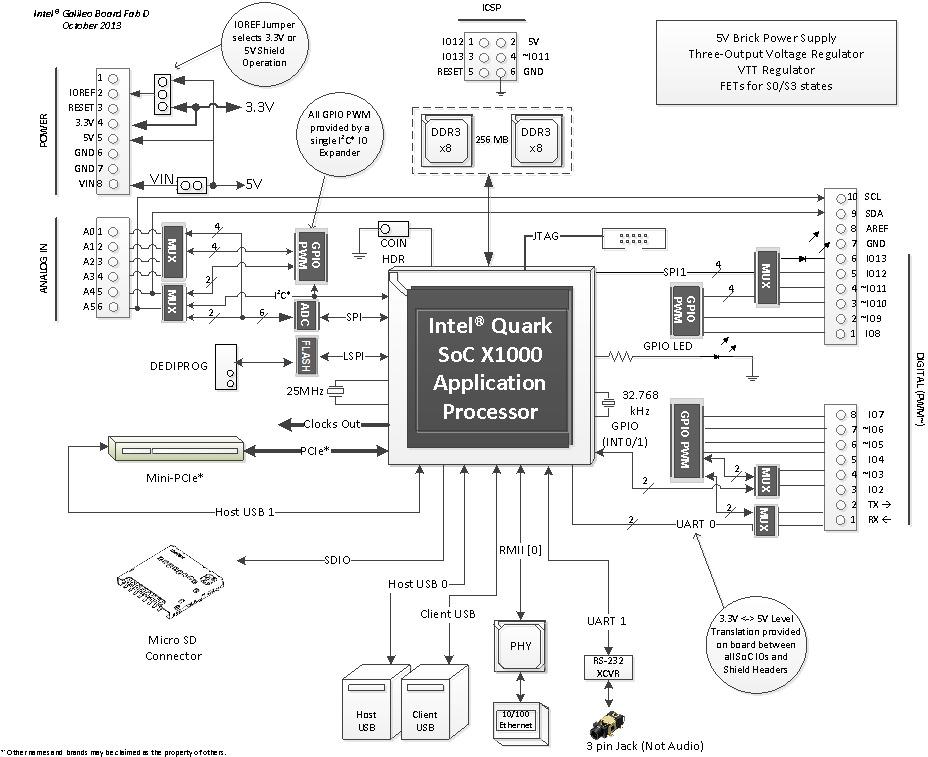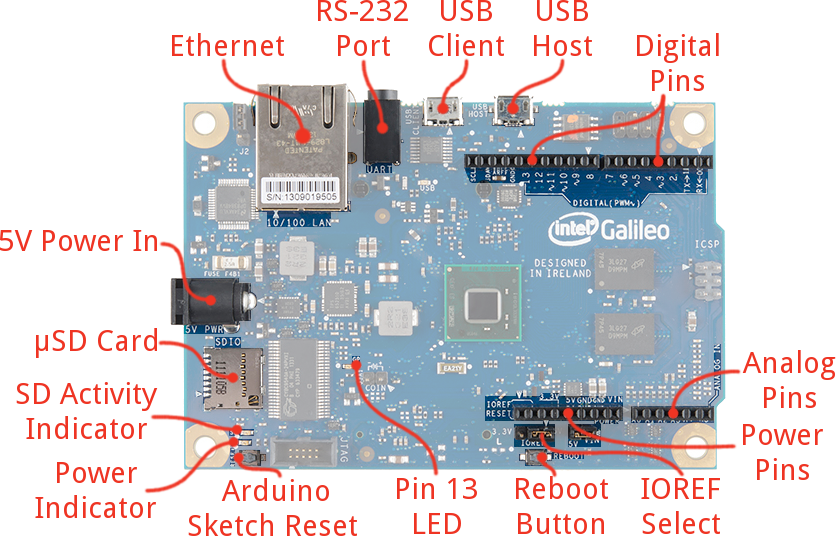Introduction
Design is an important element of marketing because it determines the uniqueness and competitive edge a product will have when released into the market. Effective design methods consider technical and market factors before developing and releasing products into the market. Although managers are aware of this, the fast-paced nature of the markets requires companies to make quick decisions to remain competitive.
Desperate to get a position in the low-power gadget industry, Intel partnered with Arduino to release the Intel Galileo. The Galileo a board created by Intel, which functions with Arduino and has 1/0 ports, Ethernet ports, Memory Card slots, serial ports, and USB connectivity. This paper presents the features of the Intel Galileo and compares it with similar products in the low-power device industry.
Design of the Intel Galileo
A product’s design distinguishes it from other products in the market. Figure 1 is the block diagram for Intel’s Galileo. At the centre of the Galileo is a 400MHz mono-core Quark, designed similarly to Intel’s Pentium family (Lehrbaum 1).
This similarity with Pentium’s design gives programmers an acquainted experience and allows the Galileo to run a complete Linux kernel (Lehrbaum 1). An advantage of Galileo is its design, which includes fully Arduino compatible pin headers and a circuit that enables communication between the Quark and all Shields (Richardson 1). Intel Galileo’s features are summarised in the in this section.

Intel Galileo features an IDE that modifies Arduino’s IDE and can improve the firmware (Richardson 1). Furthermore, the Ethernet library compatibility featured by Galileo, for internet connectivity, is simple to use (Richardson 1). Most Linux boards rely on a connection to the Internet to get the current date and time.
Another significant feature of the Galileo is its inclusion of a real-time clock. Wiring a 3 Volts battery will keep the real-time clock functional even after the board is switched off (Richardson 1). At the end of the Galileo’s board is a space “for PCI Express Mini cards” (Richardson 1), which enables wireless connectivity and memory expansion.
A USB port is provided on Galileo’s board and allows users to connect external devices via a USB Host library powered by Arduino (). The Galileo enables microSD connectivity and supports TWI/I2C, SPI connection through Arduino’s SD and Wire libraries respectively (Richardson 1).

Figure 2 presents a labelled diagram of Galileo’s board. The Galileo allows serial connectivity by providing standard serial ports and additional serial ports that allow users to input Linux commands from their computers (Richardson 1). The Galileo board comes with light circuitry of Linux on its 8 Megabits storage (Halfacree 1), which allows the use of tools, such as Python, node.js, ALSA, openCV, and SSH.
Intel Galileo vs. Raspberry pi/Arduino
Although the Galileo is a unique product, it can be compared with other products in the low-power device industry. This section of the report compares Intel’s Galileo with other low-power devices, namely the Raspberry Pi and Audruino. Memory is an important element in the design of low-power devices. While the Galileo boasts of a 400MHz CPU, the Arduino Uno and Arduino Due have 16MHz and 84MHz CPUs respectively.
Thus, the Galileo has a faster processor and offers more memory and plug-in abilities. The difference in memory capacity reflects in the pricing of the Galileo, which is sold for £60 against £20 and £40 for the Uno and Due respectively. Asides being more expensive, the Galileo performs poorly against the Raspberry Pi.
In a test performed to compare the devices, it took the Galileo 25.9 seconds to compress a 10MB document, which was compressed in 8.3 seconds by the Raspberry Pi (Halfacree 1). Apart from its slow performance, Galileo’s electrical structure of compatibility has limited bandwidth (Halfacree 1).
Despite the difference in memory capacity, the Galileo and Arduino are both micro-controllers, without operating systems, running on the same software (Halfacree 1). Both systems neither run on an Operating System (OS) but function when users upload software from a PC (Halfacree 1).
Raspberry Pi, which is a complete computer with an OS and file system, differs from Galileo and Arduino. The Raspberry Pi allows users to connect peripherals, such as mouse, webcams, and keyboards, and operate computer programs. The Raspberry Pi has a 900MHz CPU and a Random Access Memory of 1GB (Halfacree 1), which gives it a better speed than Galileo and Arduino. The disadvantage of the Raspberry Pi however, is that it boots slower when powered, while Arduino runs immediately it is switched on.
Conclusion
The purpose of this report was to research the features of the Galileo and compare it with other low-power devices. Although the Galileo is a remarkably advanced board for the use of a Quark, it performs poorly compared to inexpensive microcontroller-based contenders. The Galileo’s competitive disadvantage is influence by various factors, including limited compatibility bandwidth, slow speed, expensive pricing, and lack of an operating system.
Works Cited
Halfacree, Gareth. n.d. Intel Galileo Review.
Lehrbaum, Rick 2014, Intel unveils second generation Galileo hacker SBC
Richardson, Matt 2013, 10 Great Intel Galileo Features. 2013.